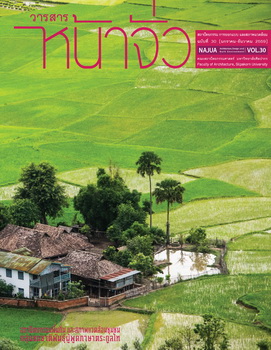การถอดบทเรียนภูมิปัญญาการปรับตัวของเรือนพื้นถิ่นไทใหญ่ บ้านแม่สามแลบ จังหวัดแม่ฮ่องสอน
Keywords:
การถอดบทเรียน, ภูมิปัญญา, การปรับตัว, เรือนพื้นถิ่น, ไทใหญ่, บ้านแม่สามแลบ, Lessons learnt, Vernacular wisdom, Adaptation, Tai Yai House, Baan Mae Sam LapAbstract
บทความนี้มุ่งค้นหาบทเรียนภูมิปัญญาการปรับตัวในเรือนพื้นถิ่นไทใหญ่ บ้านแม่สามแลบ จังหวัดแม่ฮ่องสอน โดยมีวัตถุประสงค์เพื่อสำรวจลักษณะการตั้งถิ่นฐานบ้านเรือนในที่ตั้งที่มีลักษณะเฉพาะทางกายภาพ เพื่อถอดบทเรียนภูมิปัญญาและอภิปรายพลวัตการปรับตัวของสถาปัตยกรรมพื้นถิ่นในการปรับตัวสร้างเรือนพักอาศัยพื้นถิ่นในพื้นที่เฉพาะทั้งในปัจจุบันและอนาคต งานวิจัยใช้วิธีวิจัยเชิงคุณภาพด้วยการสำรวจภาคสนามเรือนไทใหญ่ในพื้นที่บ้านแม่สามแลบ จังหวัดแม่ฮ่องสอน ซึ่งที่ตั้งอยู่บนไหล่เขา มีที่ดินจำกัด มีสภาพที่ตั้งไม่มั่นคงจากดินโคลนถล่มและน้ำป่าไหลหลาก จำเป็นต้องสร้างเรือนเกาะไปตามไหล่เขา การเก็บข้อมูลภาคสนามมีกลุ่มตัวอย่างจำนวน 20 หลังคาเรือน และนำข้อมูลถิ่นฐานบ้านเรือนมาวิเคราะห์ในประเด็นเกี่ยวกับลักษณะเฉพาะของการตั้งถิ่นฐาน รูปแบบผังหมู่บ้าน ลักษณะเรือน แล้วจึงถอดบทเรียนภูมิปัญญาการปรับตัวตามสภาพแวดล้อม ผลวิจัยพบบทเรียนของการสร้างและปรับตัวของเรือนพื้นถิ่นที่เหมาะสมกับพื้นที่ตั้งที่มีการปรับไปตามเงื่อนไขที่เปลี่ยนแปลงอย่างต่อเนื่อง จนเกิดเป็นรูปแบบเรือนพื้นถิ่นที่จัดวางบนที่ลดหลั่นตามความลาดชันของไหล่เขา ตัวเรือนยกสูงให้พ้นนํ้าท่วมและนํ้าป่าไหลหลาก ใช้การปรับหน้าดินเป็นขั้นบันใดตามสภาพความชัน สร้างกำแพงกันดินเพื่อป้องกันดินทรุดและเพื่อใช้เป็นฐานรับโครงสร้างเสา ใช้วัสดุประกอบสร้างเรือนที่หาได้ในท้องที่ เป็นวัสดุจากธรรมชาติที่มีนํ้าหนักเบาและเหมาะสมกับภูมิศาสตร์ที่ตั้ง องค์ความรู้จากการถอดบทเรียนภูมิปัญญาการปรับตัวของเรือนพื้นถิ่นบ้านแม่สามแลบสะท้อนการปรับตัวของสถาปัตยกรรมพื้นถิ่นภายใต้เงื่อนไขเดิมของชาติพันธุ์กับเงื่อนไขใหม่ของที่ตั้ง ให้เกิดรูปแบบที่ผสมผสานระหว่างลักษณะทางชาติพันธุ์และลักษณะเฉพาะตามเงื่อนไข องค์ความรู้ที่สามารถปรับใช้เพื่อใช้รับมือกับลักษณะที่ตั้งและความผันแปรของสภาพแวดล้อมที่เปลี่ยนแปลงในรูปแบบอื่นๆ ที่เป็นประเด็นสำคัญของโลกในปัจจุบันด้วย
Seeking lessons from folk wisdoms involved in the adaptation of vernacular Tai-Yai houses at Baan Mae Sam Lap, Mae Hong Son Province
Savitri Srisawat
Master of Architecture Program, Faculty of Architecture, Chiangmai University
Rawiwan Oranratmanee
Faculty of Architecture, Chiangmai University
This study aimed to seek lessons that can be learnt from the ways in which Tai-Yai settlement at Baan Mae Sam Lap was set up and adapted to suit particular conditions of the physical environment. The dynamic aspects of adapting vernacular structures to suit specific locations for present and future construction of dwellings are also discussed in this paper. Qualitative method was used in carrying out the research which was based on field survey of houses in the Tai-Yai settlement at Baan Mae Sam Lap. The village occupies modest land area on a hilly terrain that faces constant problems of landslide and torrential flooding. In conducting the investigation, 20 houses were selected as case studies, and collected field information were analyzed in terms of settlement pattern, village layout, and physical characteristics of the houses.Lessons on wisdom in adapting to the physical environment were then drawn from the findings. Results show that in adapting to suit environmental conditions, dwellings were laid out in accordance with the terrain. Land was levelled in steps along the sloping contours, houses raised high above flood level, and retaining walls built to prevent land from subsiding as well as to bear weight of structural house components. Materials used for construction are lightweight natural materials that can be obtained locally and are environmentally suitable. Lessons drawn from the adaptation of house-form at Baan Mae Sam Lap illustrate the wisdoms used in finding appropriate solutions to satisfy original ethnic requirements under the constraints and conditions of the physical environment whereby ethnic criteria and local criteria have been taken into consideration together. This knowledge can also be applied to other sites and locations with similar environmental predicament which is at present becoming an important global issue.





